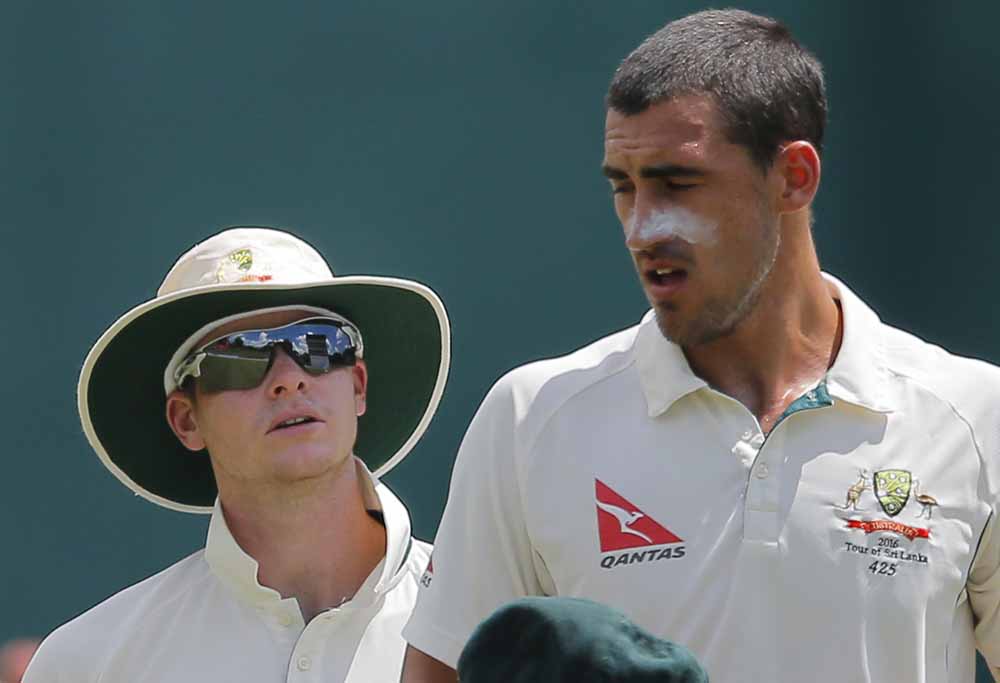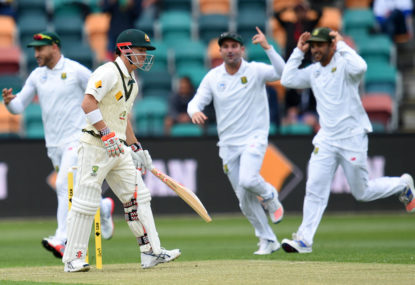Just when you thought things couldn’t get any worse for Australian cricket fans following the first Test in Perth, Hobart happened.
Here are five talking points from the second Test against South Africa.
» Highlights from the second Test, not that you want to watch them
Australia’s batting is not good enough
There’s not much more that needs to be said about Australia’s batting that you haven’t already heard, but it bears repeating purely to emphasise how bad the performance was.
Whether it was poor shot selection (David Warner), critical yet basic errors (Callum Ferguson) or simply being undone by the moving ball (just about everyone else), the first innings in Hobart made it abundantly clear that the Australian batting order is not suited to playing in remotely bowler-friendly conditions.
The second innings wasn’t much better. Although Warner was unlucky and both Steve Smith and Usman Khawaja showed some kind of composure, the remainder of the batting order offered about as much resistance as a house of cards, playing poor shots and not placing enough value on their wicket. Losing 8-32 in the second innings says it all, really.
It’s hardly anything new, though.
Australia were found wanting against the moving ball during last year’s Ashes series and were similarly inept on the turning tracks in Sri Lanka. A day-night Test against South Africa’s pink ball-armed bowlers doesn’t bode well.
Given the sub-par batting performance on the relatively flat Perth deck last Test as well, the calls for changes to the batting line-up are only going to increase.

It’s time to give youth a chance
So what changes could be made?
» Pick your Australian XI for the third Test vs South Africa
The man under the most pressure now is surely Adam Voges. Having failed with the bat in Perth with scores of 27 and 1, his total return of two runs in Hobart – particularly with that dreadful-looking pull shot which cost him his wicket in the second innings – will have Australia’s horde of young batsmen licking their lips.
Ronan O’Connell wrote at length this morning that it is time for Australia to look to youth for their solution to their batting frailties, and it’s hard to disagree.
Peter Handscomb is one player who will be eyeing off a maiden Test cap, while Kurtis Patterson and Jake Lehmann also deserve consideration having enjoyed fine first-class seasons last year.
They don’t offer the experience of Voges, they do have plenty of potential, and an Australian berth this summer would allow them to blossom as Test players down the order, much in the same vein as the likes of Ponting, Border and Waugh the elder.
Have we found a keeper who is deserving of the Gilchrist comparisons?
Ever since the retirement of Adam Gilchrist, it has been the unfair fate of every talented wicketkeeper-batsman to be compared to the legendary Australian gloveman.
For most, it is a comparison that does no-one any good, but in the case of Quinton de Kock, it may just be deserved.
De Kock’s ability to either rescue his side with a composed innings or rub salt into an opposition’s bowling wounds with a blistering knock is noticeably Gilchrist-like. The South African did the former in Perth, while his century in Hobart – his fifth consecutive score over fifty – certainly did the latter.
A Test average of 51 after 17 innings is mightily impressive for anyone, let alone a wicketkeeper-batsman, and with Temba Bavuma also looking the goods, South Africa’s batting stocks look to be in safe hands heading into the future.
Patience is a virtue
Terrible as Australia’s batsmen were, the side’s bowlers are hardly faultless for the calamity that occurred in Hobart.
Bowling on a seamer-friendly deck, Australia’s quicks bowled with a desperation for wickets that did them no good whatsoever. Rather than seeking to build pressure, there seemed to be an emphasis on finding the miracle ball to take a wicket.
The result was a collection of loose deliveries, allowing South Africa to turn the strike over and release any scoreboard pressure on the rare occasions Australia were able to build it.
Look no further that the maiden count for evidence of this. In their 93 overs for the match, South Africa bowled 22 maidens. Australia could manage just 19 out of 101, ten of which came from the excellent Josh Hazlewood, who was the only Aussie to leave Hobart with an unbesmirched reputation thanks to his six-wicket haul.
To be fair, this was the second Test in a row where the bowlers were let down by their batsmen, who once again failed to post an adequate first-innings score.
But some added discipline and patience with the ball could well have prevented the Proteas from building up such a commanding lead, one which saw them to a comfortable innings victory.

South Africa’s selectors are switched on
When Dale Steyn went down with a series-ending shoulder injury in Perth, many people thought it would be a foregone conclusion that beanpole quick Morne Morkel would step into the side.
A bowler capable of extracting a frightening amount of bounce from the wicket, Morkel is well-suited to bowling in Australia and has done so before on previous tours. But instead of drafting in the towering seamer, the Proteas opted instead for Kyle Abbott, known better for hitting a full length and getting the ball to swing and seam around.
Needless to say, the selection worked.
Abbott picked up nine wickets in a man-of-the-match display, constantly attacking the Australian batsmen. That’s not to say he wasn’t well-supported – Vernon Philander and Kagiso Rabada both grabbed five scalps during the Test – but it does show South Africa’s selectors knew exactly who the right man for the job was for this Test.
With Jackson Bird watching on as Australia struggled to make inroads on the ground he has made his own in the Sheffield Shield, one can’t help but think Australia’s selectors might not be quite as attuned as their South African counterparts.































































































